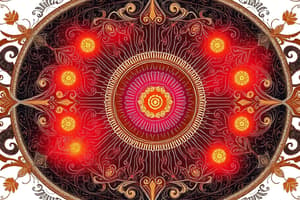Podcast
Questions and Answers
What happens when a diode is forward biased?
What happens when a diode is forward biased?
- Very little current flows and the diode acts as a barrier
- The diode emits light
- Electrons flow across the junction and current flows (correct)
- The diode permits current flow when reverse-biased
In which scenario does a diode function as a barrier?
In which scenario does a diode function as a barrier?
- At its Zener voltage
- When there is high current flow
- Reverse biased (correct)
- Forward biased
What is the purpose of Zener diodes in electronics?
What is the purpose of Zener diodes in electronics?
- To regulate voltage and protect against overvoltage (correct)
- To convert electrical energy into light energy
- To convert light energy into electric current
- To rectify AC current into DC current
How are semiconductor diodes used in solar cells?
How are semiconductor diodes used in solar cells?
What role do diodes play in power supplies?
What role do diodes play in power supplies?
What is the main function of a semiconductor diode?
What is the main function of a semiconductor diode?
How do semiconductors differ from insulators and metals in terms of electrical conductivity?
How do semiconductors differ from insulators and metals in terms of electrical conductivity?
What is a P-N junction in a semiconductor diode?
What is a P-N junction in a semiconductor diode?
Why is it important to have different doping concentrations at the P-N junction of a semiconductor diode?
Why is it important to have different doping concentrations at the P-N junction of a semiconductor diode?
In what type of modern devices can semiconductor diodes be found?
In what type of modern devices can semiconductor diodes be found?
Flashcards are hidden until you start studying
Study Notes
Semiconductor Diodes: Harnessing One-Way Electric Currents
Semiconductor electronics has revolutionized modern technology, enabling the development of miniature, powerful, and energy-efficient devices. At the heart of this revolution are semiconductor diodes, devices that act as one-way valves for electric currents.
Semiconductors and Diodes
Semiconductors are materials with electrical conductivity that lies between metals and insulators. Unlike metals, which conduct electricity well, and insulators, which don't conduct at all, semiconductors have their conductivity tuned by altering their properties.
Semiconductor diodes are based on this tunable conductivity. By designing specific structures within semiconductor materials, we can create devices that allow electric current to flow in one direction but not the other. These diodes are ubiquitous in modern electronics, from simple devices like the humble LED light to complex applications like solar panels and power supplies.
P-N Junction Diodes
The foundation of semiconductor diodes is the P-N junction. This is a region where a semiconductor material has two different doping concentrations — one region containing an abundance of positively charged "holes" (p-type) and another region containing an abundance of negatively charged electrons (n-type). At the P-N junction, these oppositely charged carriers form an electric field, effectively creating a barrier that prevents electric current from flowing in one direction.
Forward and Reverse Biases
When a diode is connected with its anode (p-type) at a higher voltage than its cathode (n-type), a forward bias is applied. This causes electrons to flow across the junction and current to flow, producing a light or power. When the opposite occurs, with the anode at a lower voltage than the cathode, a reverse bias is applied. Under this condition, very little current flows, and the diode acts as a barrier.
Zener Diodes
Zener diodes are a type of diode that permits current flow when reverse-biased, but only when the reverse voltage exceeds a specific, predetermined value called the Zener voltage. This property makes Zener diodes particularly useful for voltage regulation and protection against excess voltage.
Application in LEDs, Solar Cells, and Power Supplies
Semiconductor diodes are critical components in LEDs, solar cells, and power supplies.
- LEDs: Diodes are used to convert electrical energy into light energy. When an electric current flows through a diode in a forward bias, it emits light.
- Solar cells: These cells use semiconductor diodes to convert light energy into electric current, a process known as the photovoltaic effect.
- Power supplies: Diodes are employed in power supplies to rectify alternating current (AC) into direct current (DC), regulate voltage levels, and protect against overvoltage.
Conclusion
Semiconductor diodes have revolutionized modern electronics by enabling the harnessing of one-way electric currents. The P-N junction, forward and reverse bias, and other types of diodes like Zener diodes have made diodes indispensable components in LEDs, solar cells, and power supplies, among other applications. The evolution of semiconductor diodes continues to drive technological innovation, and their widespread use will only advance further as new materials and fabrication techniques are developed.
Studying That Suits You
Use AI to generate personalized quizzes and flashcards to suit your learning preferences.




